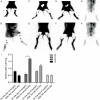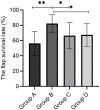Effects of arterial blood supply on the survival of reverse-flow island flaps: an experimental study
- PMID: 35958448
- PMCID: PMC9360870
Effects of arterial blood supply on the survival of reverse-flow island flaps: an experimental study
Abstract
Objectives: This study aimed to investigate the effect of arterial blood supply on the survival area of retrograde island flap.
Methods: The vein and saphenous artery in rabbits were selected to design the reverse-flow island flap experimental model. Forty rabbits were randomly divided into four groups: control group (group A), partial anastomosis of the saphenous artery group (group B), partial anastomosis of the vein group (group C), and no superficial vein group (group D). Flap survival was observed postoperatively, the survival area was measured, and the survival rate was compared. Blood distribution in the flap at different time points was observed by radionuclide imaging.
Results: The blood vessel distribution and blood cell status were observed histologically. The survival rate of flaps in group B was higher than that of the other three groups (P < 0.05). The radioactive material (RM) could be seen clearly in group B, whereas those in groups A, C, and D existed transiently. The RM in group B was higher than that in groups A, C, and D (P < 0.05). On postoperative day 10, group B had more capillary regeneration and blood cells than the other three groups (P < 0.05).
Conclusions: Increasing blood supply can improve the survival rate of flaps, but simply promoting venous return has no significant effect on the survival rate of flaps.
Keywords: Reverse-flow island flaps; pressurization; survival rate; venous drainage.
AJTR Copyright © 2022.
Conflict of interest statement
None.
Figures





References
-
- Lee HI, Ha SH, Yu SO, Park MJ, Chae SH, Lee GJ. Reverse sural artery island flap with skin extension along the pedicle. J Foot Ankle Surg. 2016;55:470–475. - PubMed
-
- Qiu D, Wang X, Wang X, Jiao Y, Li Y, Jiang D. Risk factors for necrosis of skin flap-like wounds after ED debridement and suture. Am J Emerg Med. 2019;37:828–831. - PubMed
-
- Radomski OA, Radomska NY, capital Ka CcIU, Yaremenko LM, Sankova LY, Kovalchuk VM. “To and fro” blood flow mathematical model in venous flap survival. Wiad Lek. 2021;74:1960–1963. - PubMed
-
- Wang Y, Chen SY, Gao WY, Ding J, Shi W, Feng XL, Tao XY, Wang L, Ling DS. Experimental study of survival of pedicled perforator flap with flow-through and flow-end blood supply. Br J Surg. 2015;102:375–381. - PubMed
LinkOut - more resources
Full Text Sources
